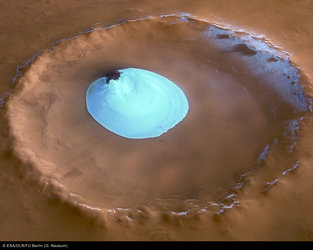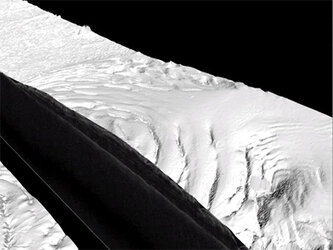Interview: The martian water cycle and climate
With Robert Haberle, NASA Ames Research Center and Oleg Korablev, Space Research Institute, Moscow, Russia.
How would you describe the martian water cycle?
Robert Haberle, NASA Ames Research Center [RH]: It is much less intense than on Earth. Nevertheless, water vapour content varies substantially in the atmosphere of Mars, both with the season and by geographical location. What we have to do is measure the amount of water vapour, then work out where it is coming from and where it is going.
What effect does water vapour have on the martian atmosphere?

Oleg Korablev, Space Research Institute, Moscow, Russia [OK]: Water vapour in the atmosphere of Mars is a signature of water being transported around the planet. Water ice exists on Mars in the polar caps and within the soil. If it is going to move from one place to another, it must evaporate or sublimate and enter the atmosphere. Once in the atmosphere, it can make clouds and these clouds reflect solar radiation back into space. So the clouds have a cooling effect on the martian climate.
There are observations of water vapour that stretch back to NASA’s Viking missions in the 1970s, how do the new Mars Express res

RH: They show a drier water cycle than previously. This means that there could be significant annual variations and, if true, that could be very interesting. If we believe the results as they stand, they tell us that, at the time of the Viking missions, there was almost twice the quantity of water in the atmosphere over the north pole of Mars as there is now.
Is there any doubt about the older results?
OK: The spectroscopic database used to interpret the Viking results was incomplete. This may mean that the analysis over-estimated the wetness of the atmosphere. It is too early to be certain about this but it looks as though a re-analysis using modern techniques may make them more consistent with the Mars Express results. This would suggest a more stable martian water cycle. Scientifically, that would be less fascinating but probably more reasonable.
What are the major sources of water on Mars?
RH: That’s the $64,000 question! The north polar cap must be a major water source. By the summer, the carbon dioxide ice at the pole has evaporated away revealing a layer of water ice beneath. This can then sublimate into the atmosphere. At the south, the carbon dioxide ice never completely goes away, so the water there remains trapped. Computer models suggest that the sublimation and condensation of the north pole is responsible for the major features of the martian water cycle.











